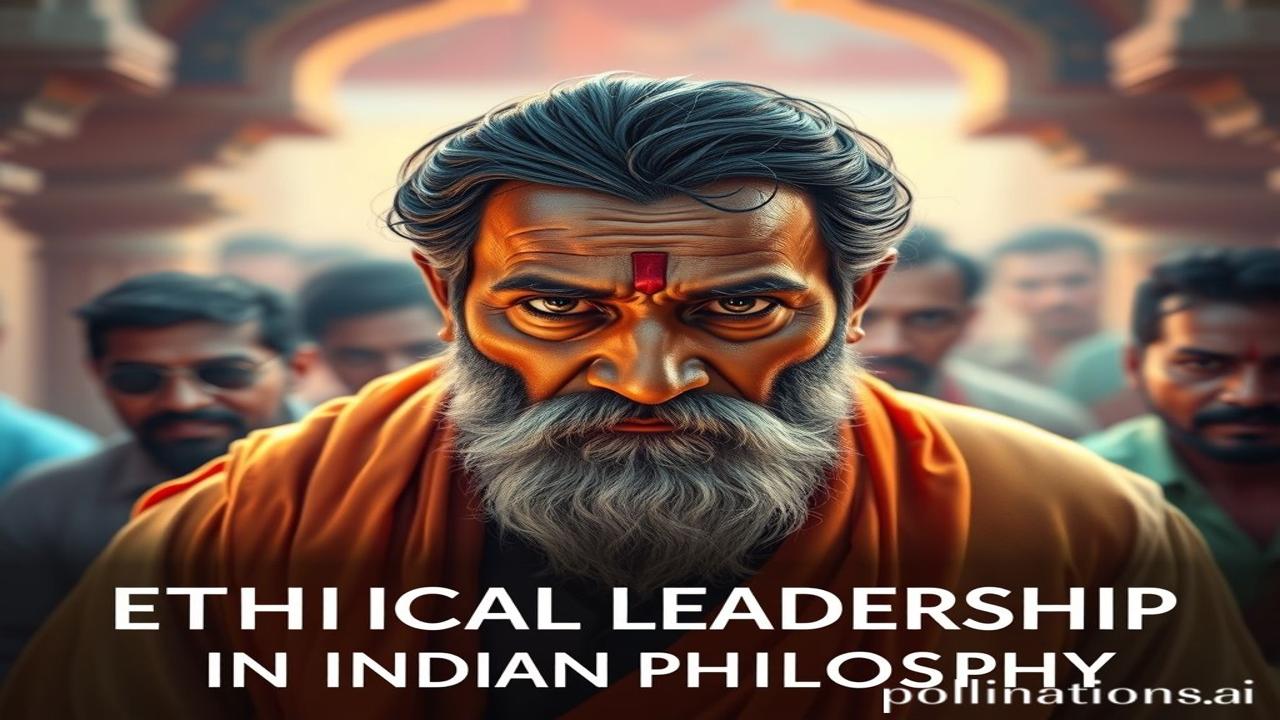Ethical Leadership in Indian Philosophy: Kya Hum Bhool Gaye?
Kabhi socha hai, Mahabharat ke yudh mein, sirf Arjun ne hi toh sawal nahi poochhe honge? Dhritarashtra, apne antar-mann se, kitne sawal karte honge? That constant tug-of-war between personal ambition and dharma… it’s a struggle that resonates even today. The rustling leaves, the scent of sandalwood, the echoes of ancient chants – all hold secrets about ethical leadership, a concept deeply ingrained in Indian philosophy. Aajkal, jab leadership sirf power and profit ke bare mein ho gayi hai, it’s time to dust off the ancient scrolls and remember what our dharohar truly means.
Itihasic Pishthabhumi: Roots in the Vedas and Beyond
Ethical leadership, in the Indian context, isn’t just about following rules. It’s about dharma, karma, and a profound sense of responsibility. This concept finds its roots in the Vedas, Upanishads, and the Bhagavad Gita. Think of it as a cosmic order, a moral compass guiding individuals and leaders alike.
- When and Where? This concept has evolved over millennia, from the Vedic period (around 1500 BCE) to the Mauryan Empire and beyond. Different philosophical schools like Jainism, Buddhism, and Hinduism contributed to its understanding.
- What? Ethical leadership is about leading with integrity, compassion, and a focus on the well-being of all. It emphasizes selfless service (seva), truthfulness (satya), non-violence (ahimsa), and justice (nyaya).
- Why Important? Because a leader’s actions ripple through society. A corrupt leader breeds corruption; an ethical leader inspires ethical behavior. It’s about creating a dharma-centric society, where individuals thrive and flourish. Ashoka, the Mauryan emperor, a shining example! He converted to Buddhism after the Kalinga War and dedicated his life to dhamma vijaya – conquest through righteousness.
Zamini Sach – Log Aur Jeevan: Daily Life and Ideals
Imagine a village, say 3000 years ago. The gramaani (village headman) isn’t just the most powerful person; he’s also the most respected.
- He wakes before dawn, meditates, and then attends to the needs of his villagers.
- His clothes are simple, his food is humble, and his door is always open.
- “Beta, agar koi pareshani hai toh mujhse kehna,” he’d say, his voice filled with genuine concern.
- Ma Sita, with her unwavering devotion to dharma, became a symbol of ethical leadership for women. She faced immense hardship with grace and integrity.
- Farmers consult him on land disputes, artisans seek his advice on crafting their wares, and warriors train under his guidance, learning not just combat but also compassion.
This wasn’t just about power; it was about seva – selfless service to the community. Even kings were expected to be rajadharma-adhering, protectors of their people, not exploiters.
Dharohar Aur Pehchan: Echoes in Modern India
Ethical leadership in Indian philosophy isn’t some dusty relic of the past. It continues to echo in our sanskar, our values, and even in our modern institutions.
- Think of Mahatma Gandhi. His life was a testament to satya and ahimsa, principles deeply rooted in Indian thought. He showed the world that ethical leadership can move mountains.
- We see glimpses of it in social enterprises that prioritize people over profit, in community leaders who work tirelessly to uplift the marginalized, and even in everyday acts of kindness and compassion.
- Bharatiyata, our sense of Indianness, is inextricably linked to this ethical framework. It’s about striving for a society that is just, equitable, and compassionate. The concept of ‘Vasudhaiva Kutumbakam’ – the world is one family, speaks volumes about the ethical compass.
Mazedar Tathya ya Bhram-Bhanjak: Fun Facts and Myth-Busters
- Myth: Ethical leadership is only for saints and ascetics.
Truth: Ethical leadership is for everyone, from the CEO of a multinational corporation to the head of a household. It’s about making ethical choices in every aspect of life. - Did you know? The Arthashastra, written by Chanakya, although known for its political strategies, also emphasizes the importance of ethical governance for a prosperous kingdom. It highlights the need for leaders to be just, compassionate, and dedicated to the welfare of their people. It’s not just about power; it’s about responsible power.
Drishya Aur Bhavnayein: A Sensory Symphony
Imagine walking through a temple courtyard in the fading light of dusk. The air is thick with the scent of incense and jasmine. The temple bells chime, their sound echoing through the surrounding hills. The cool stone of the temple walls feels smooth beneath your fingertips. You hear the chanting of mantras, their rhythm soothing and hypnotic. You see the faces of devotees, their eyes filled with devotion and peace. This is the atmosphere that nurtured the ideals of ethical leadership – a space of reflection, contemplation, and connection to something larger than oneself.
Antim Vichar ya Uddharan: A Closing Thought
The path to ethical leadership is not easy. It requires courage, integrity, and a willingness to challenge the status quo. But as the Bhagavad Gita reminds us:
“कर्मण्येवाधिकारस्ते मा फलेषु कदाचन। मा कर्मफलहेतुर्भूर्मा ते सङ्गोऽस्त्वकर्मणि॥”
(karmanye vadhikaraste maa phaleshu kadachana, maa karmaphalaheturbhurmaa te sangostvakarmani)
“You have the right to perform your prescribed duty, but you are not entitled to the fruits of action. Never consider yourself to be the cause of the results of your activities, and never be attached to not doing your duty.”
So, let us strive to lead with dharma, with karma, and with a deep sense of responsibility. Let us be the leaders that India needs – leaders who inspire, who empower, and who create a better future for all.
